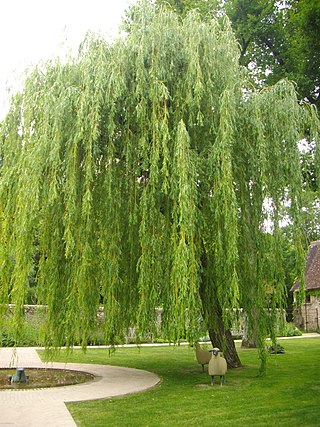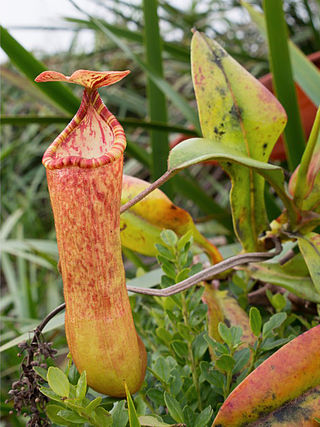Genus is a taxonomic rank used in the biological classification of living and fossil organisms as well as viruses. In the hierarchy of biological classification, genus comes above species and below family. In binomial nomenclature, the genus name forms the first part of the binomial species name for each species within the genus.

In taxonomy, binomial nomenclature, also called binominal nomenclature or binary nomenclature, is a formal system of naming species of living things by giving each a name composed of two parts, both of which use Latin grammatical forms, although they can be based on words from other languages. Such a name is called a binomial name, a binomen, binominal name, or a scientific name; more informally it is also historically called a Latin name.

The International Code of Zoological Nomenclature (ICZN) is a widely accepted convention in zoology that rules the formal scientific naming of organisms treated as animals. It is also informally known as the ICZN Code, for its publisher, the International Commission on Zoological Nomenclature. The rules principally regulate:

Hornbeams are hardwood trees in the plant genus Carpinus in the family Betulaceae. The 30–40 species occur across much of the temperate regions of the Northern Hemisphere.

Salix babylonica is a species of willow native to dry areas of northern China, but cultivated for millennia elsewhere in Asia, being traded along the Silk Road to southwest Asia and Europe.
In botanical nomenclature, author citation is the way of citing the person or group of people who validly published a botanical name, i.e. who first published the name while fulfilling the formal requirements as specified by the International Code of Nomenclature for algae, fungi, and plants (ICN). In cases where a species is no longer in its original generic placement, both the authority for the original genus placement and that for the new combination are given.
In biology, a homonym is a name for a taxon that is identical in spelling to another such name, that belongs to a different taxon.

A conserved name or nomen conservandum is a scientific name that has specific nomenclatural protection. That is, the name is retained, even though it violates one or more rules which would otherwise prevent it from being legitimate. Nomen conservandum is a Latin term, meaning "a name to be conserved". The terms are often used interchangeably, such as by the International Code of Nomenclature for Algae, Fungi, and Plants (ICN), while the International Code of Zoological Nomenclature favours the term "conserved name".
In zoological nomenclature, a nomen oblitum is a disused scientific name which has been declared to be obsolete in favour of another 'protected' name.

Andropogon is a widespread genus of plants in the grass family, native to much of Asia, Africa, and the Americas, as well as Southern Europe and various oceanic islands.
In biological nomenclature, a nomen novum, new replacement name is a scientific name that is created specifically to replace another scientific name, but only when this other name cannot be used for technical, nomenclatural reasons. It does not apply when a name is changed for taxonomic reasons. It is frequently abbreviated, e.g.nomen nov., nom. nov..

In taxonomy, an undescribed taxon is a taxon that has been discovered, but not yet formally described and named. The various Nomenclature Codes specify the requirements for a new taxon to be validly described and named. Until such a description has been published, the taxon has no formal or official name, although a temporary, informal name is often used. A published scientific name may not fulfil the requirements of the Codes for various reasons. For example, if the taxon was not adequately described, its name is called a nomen nudum. It is possible for a taxon to be "undescribed" for an extensive period of time, even if unofficial descriptions are published.

Priority is a fundamental principle of modern botanical nomenclature and zoological nomenclature. Essentially, it is the principle of recognising the first valid application of a name to a plant or animal. There are two aspects to this:
- The first formal scientific name published for a plant or animal taxon shall be the name that is to be used, called the valid name in zoology and correct name in botany.
- Once a name has been used, no subsequent publication of that name for another taxon shall be valid (zoology) or validly published (botany).

Nepenthes sumagaya is a tropical pitcher plant native to the Philippines. It is known only from Mount Sumagaya in north-central Mindanao, where it grows in open areas at elevations from 1600 m above sea level to the summit at 2247 m. It is sympatric with N. pantaronensis and possible hybrids between these species have been recorded. Owing to its unusual combination of morphological characters, N. sumagaya has no obvious close relatives in the genus.

Cinna is a small genus of grasses known by the common name woodreeds. There are only four known species but they are quite widespread in the Americas and northern Eurasia.
Fusus is a genus of small to large sea snails, marine gastropod molluscs in the family Fasciolariidae, the spindle snails and tulip snails.

In biological classification, a species inquirenda is a species of doubtful identity requiring further investigation. The use of the term in English-language biological literature dates back to at least the early nineteenth century.

This is a list of terms and symbols used in scientific names for organisms, and in describing the names. For proper parts of the names themselves, see List of Latin and Greek words commonly used in systematic names. Note that many of the abbreviations are used with or without a stop.

Salix aegyptiaca, known as the Persian willow, is a large shrub or small tree from the genus of willow (Salix) with red branches that are tomentose in the first two years and leaves up to 15 centimeters long. The natural range of the species is in the Caucasus and in western Asia. It is cultivated in many countries.
Caetano Xavier dos Remedios Furtado was a botanist who specialized in palms. He worked at the Singapore botanical gardens. He described nearly 104 species of palms, worked on the African genus Hyphaene and on the family Araceae. The species Maxburretia furtadoana was named after him by John Dransfield in 1978. He was also involved in clarifying the terms "illegitimate" and "superfluous" names in taxonomic nomenclature. He also coined the word "basinym" which was modified as basionym.













